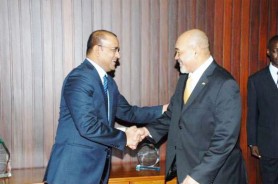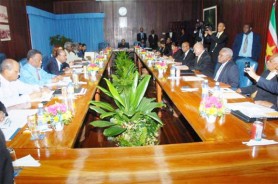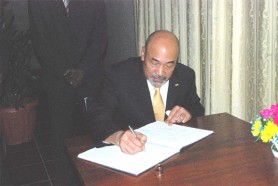Suriname’s path to international acceptability runs through Vlissengen Road
Suriname’s President Désiré Bouterse desperately needed a friend after having his inauguration snubbed by every head of state on the planet. Guyana’s President Bharrat Jagdeo came to his rescue by hosting what the official Communiqué called a one-day “working visit” to Georgetown. Judging from the abundance of topics raised, compared to the absence of concrete commitments made, the visit seemed to be more about talking than achieving workable solutions.

The Jagdeo-Bouterse encounter at the Office of the President on Vlissengen Road was not the first time that Guyana threw a lifeline to Suriname which was swimming in a sea of international opprobrium. President Desmond Hoyte had agreed to a similar ‘working visit’ by President Johannes Kraag in January 1991 at Plantation Skeldon on the Corentyne. Mr Kraag had recently been installed by Suriname’s National Army’s Acting Commander Colonel Ivan Graanoogst – then Colonel Bouterse’s trusted deputy – after the 24th December 1990 ‘Telephone Coup.’ Two days after Bouterse’s resignation as Army Comman-der, the Army telephoned President Ramsewak Shankar to inform him that he and his cabinet had been removed from office.
Johannes Kraag was appointed President on 27th December 1990. The National Assembly confirmed the Army’s choice of president without a vote and some members stormed out in protest. Jules Wijdenbosch was sworn in as the new vice-president. The ‘Telephone Coup’ caused consternation among Caribbean and South American states at the time. There was some suggestion that troops from certain concerned countries in the hemisphere were poised to intervene to restore Shankar’s democratic administration. President Hoyte could have chosen to leave Suriname to suffer in wretched isolation. He didn’t. His diplomatic decision – despite the perception that Kraag was Bouterse’s puppet – provided a veneer of respectability to the new Surinamese administration. The crisis was contained and the situation was normalised.
Suriname, twenty years on, is once again desperately seeking a strategy to secure the approbation and avoid the impending isolation of the international community. It is faced, once again, with the prospect of becoming a pariah state as the humiliation of the inauguration has already shown. The ulterior motive behind the “working visit,” therefore, is entirely demonstrative rather than developmental. It is all too clear, as President Bouterse disclosed, that Suriname has “a special movement and aspiration towards South America and the Caribbean.” Foreign Minister Winston Lackin amplified this intention earlier by explaining that, to Suriname, Guyana is the “gateway” to the Caribbean Community just as France will be its gateway to Europe. Thus, the essence of Guyana’s newly-found attractiveness is its utility as an expedient “gateway” not as an economic partner.

Suriname wants simply to satisfy its own need for international acceptability
at this point in time. It has no interest in addressing Guyana’s discomfort with its vexing territorial claim to the New River Zone. Mr Bouterse’s priority is to extricate himself from the web of international vilification before his country becomes stigmatised permanently as a criminalised state. Such a categorisation could create all sorts of problems in international relations.
It was with a clear sense of mission therefore that President Bouterse arrived at the Cheddi Jagan International Airport on 6th September. He and his team – which included Minister of Foreign Affairs Winston Lackin and Chief of Staff Harvey Naarendorp – were welcomed by Minister of Foreign Affairs Carolyn Rodrigues-Birkett without the formality of a full military Guard-of-Honour. It was no surprise, also, that after a day’s worth of talking, what emerged as the thousand-word Guyana-Suriname Communiqué was really a literary masterpiece of verbal vacuity. It succeeded in skimming ever so lightly atop every conceivable topic that officials could think about – with the obvious exception of the territorial question – without leaving a trace of the slightest solution to any matter of substance.
The sheer scale of issues was impressive but far too contrived to be of any practical value. Almost every subject – agriculture; climate change; education; energy; fisheries; food security; hydrocarbons; information technology; infrastructure development (including an improbable Corentyne River bridge); international organisation (particularly CARICOM and UNASUR); mining; public health and public security – had been dealt with exhaustively at some stage over the past 40 years. Successes have been few. Suriname sees its economic destiny not in fish and rice but in minerals – aluminium, gold and petroleum – with which Guyana can be of no assistance. Its seeks partnerships with the developed countries of Asia, Europe and the Americas.
The choice of a ‘lite’ approach to the agenda of the “working visit” by avoiding weighty topics suited Suriname’s mission. The two Presidents, according to Section 2 of the Communiqué, “exchanged ideas on ways and means of advancing their shared vision of closer relations and cooperation between Guyana and Suriname. They agreed to concentrate on building on areas that would bring the two countries closer together.” This translated, supposedly, into a deliberate decision to avoid issues, however important, on which they could not agree.
What then was the value of the Communiqué and what did the words really mean? The word ‘cooperation’ was used sixteen times in seventeen sections as if frequent repetition imparted certain inevitability. References were made to the two states’ “mutual interest,” “mutual understanding” and “shared vision.” Both states committed themselves twice to “deepening the relations” and pledged twice to “lend their full support” and promised that “no effort should be spared” to preserve the momentum of the agreement.

The two Presidents, according to section 12 of the Communiqué, “agreed to put in place a new mechanism geared towards the efficient and effective implementation of mutually agreed policies in the various areas of cooperation. This mechanism would fall directly under their respective Offices.” President Bouterse for sure, having previously superintended the Surinamese bureaucracy’s ‘old mechanism’ of stonewalling cooperation with Guyana, has now called for a “new mechanism” to be developed to accelerate development initiatives between the two countries. He said this new mechanism would see groups within the Ministries of Foreign Affairs of both countries reporting directly to the President.
President Jagdeo accepted that line of thought. He said that, in the past the Guyana-Suriname Cooperation Council and Joint Commissions which were established to oversee such developments met rarely and the discussions were mired in bureaucracy. Mr Jagdeo should allow himself to be instructed by foreign service officials at Takuba Lodge about the exertions of Suriname’s former Foreign Ministers such as Faried Pierkhan, for example, who took pains to wreck meetings of the Guyana-Suriname Cooperation Council. Back in April-May 1997, Mr Pierkhan would gleefully insist that, whatever the agenda to be discussed, Suriname’s territorial claim to the New River Zone and its sovereignty over the Corentyne River and the Atlantic maritime zone were issues had to be addressed by the Council. Minutes of the Council’s meetings would remain unsigned for several years on account of Suriname’s insistence on inserting references to its territorial claim against Guyana.
The biggest blunder of the “working visit” was Guyana’s failure to extract concrete commitments for Suriname to change specific policies that are harmful to this country’s national interests. President Jagdeo seems to believe that Guyana and Suriname agreed that “a changed philosophy” towards bilateral relations. Mr Jagdeo, speaking at a press conference at the end of the “working visit,” stated that although Guyana and Suriname have recognised that borders are important, the two countries agreed to “a changed philosophy in order to put our relationship beyond the border issues that we have had.”
This view is not one that is likely to be widely shared by many on either side of the Corentyne River. The territorial question for the last half century has never been far below the surface of Guyana-Suriname relations except, perhaps, in the imagination of a few misguided Guyanese. The records show that it has been Suriname which has consistently published and pushed its spurious map depicting the entire New River Zone as part of its territory.
It was baffling, therefore, for President Jagdeo to raise the territorial issue simply to dismiss it. He stated that in the past the border issues have overshadowed and stymied cooperation in every other area which could have been beneficial to both countries based on their geographical location and synergy. However the cooperation that would result from the new mechanism would “promote joint development” for the countries and people of Suriname and Guyana. “So,” President Jagdeo said, “while borders are important and the border issue is important, we insisted and we agreed that the engagement in the future would put our relationship beyond those and we will seek to accelerate the process.”
Present-day officials at Takuba Lodge should remind policy-makers on Vlissengen Road of the ordeal that preceded the launching of the Canawaima ferry. Guyana and Suriname signed an agreement for the ferry project since 1979 but the practical employment of the vessel was delayed until the Guyanese side conceded every single Surinamese demand concerning its use. It took all of 18 years for the final launch in 1997! The Canawaima is owned jointly by the Guyana-Suriname Ferry Company Inc today but its operation is controlled very much by the Government of the Republic of Suriname. The vessel flies the national flag of Suriname and, if an offence is committed on board, the offender will be tried in a Surinamese court.
Suriname plays ‘hardball’ on every issue that is likely to impinge even slightly on the sovereignty of the Corentyne River. Any project – such as the proposed bridge to be built there – can be expected to suffer the same diplomatic fate as the Canawaima ferry.
How can the events of 2nd and 3rd June 2000 when Suriname made history in CARICOM by sending its naval gunboats to chase a commercial petroleum exploration platform out of a maritime zone that was clearly within Guy-ana’s territory be forgotten? What response has Suriname given to Minister of Foreign Affairs Carolyn Rodrigues-Birkett who summoned the Surinamese Ambassador in Georgetown to demand an explanation for the plan by President Jules Wijdenbosch administration – supported by Mr Bouterse – for the invasion of Guyana’s New River Zone and for the failure of the Ronal Venetiaan administration “to reassure Guyanese and the international community that the use or threat of the use of force is not an option that Suriname currently embraces?” Suriname has many questions to answer.
President Désiré Bouterse, in the final analysis, got everything that he sought from the “working visit” – a souvenir visit to a country the territory of which he claims, a woolly Communiqué without any commitment to fulfilment and an album of photographs to establish his acceptability in the international community. Guyana got nothing.





